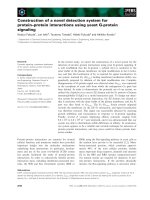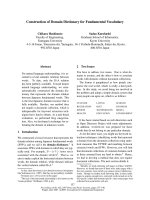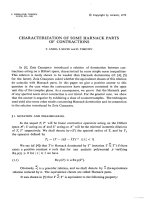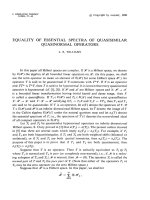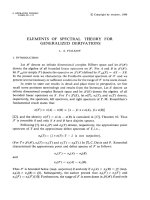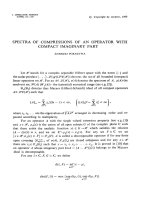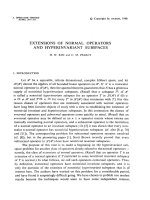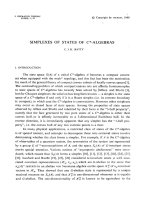Báo cáo toán học: "Construction of Codes Identifying Sets of Vertices" docx
Bạn đang xem bản rút gọn của tài liệu. Xem và tải ngay bản đầy đủ của tài liệu tại đây (149.53 KB, 9 trang )
Construction of Codes Identifying Sets of Vertices
Sylvain Gravier
CNRS - UJF, ERT´e ”Maths `a Modeler”, Groupe de Recherche G´eoD
Laboratoire Leibniz, 46, avenue F´elix Viallet, 38031 Grenoble Cedex (France)
Julien Moncel
CNRS - UJF, ERT´e ”Maths `a Modeler”, Groupe de Recherche G´eoD
Laboratoire Leibniz, 46, avenue F´elix Viallet, 38031 Grenoble Cedex (France)
Submitted: Feb 8, 2005; Accepted: Mar 1, 2005; Published: Mar 8, 2005
Mathematics Subject Classifications: 05C99, 94B60, 94C12
Abstract
In this paper the problem of constructing graphs having a (1, ≤ )-identifying
code of small cardinality is addressed. It is known that the cardinality of such a
code is bounded by Ω
2
log
log n
. Here we construct graphs on n vertices having
a(1, ≤ )-identifying code of cardinality O
4
log n
for all ≥ 2. We derive our
construction from a connection between identifying codes and superimposed codes,
which we describe in this paper.
1 Codes identifying sets of vertices
Let G =(V, E) be a simple, non-oriented graph. For a vertex v ∈ V , let us denote by
N[v] the closed neighborhood of v : N[v]=N(v) ∪{v} .LetC ⊆ V be a subset of vertices
of G, and for all nonempty subset of at most vertices X ⊆ V , let us denote
I(X)=I(X, C):=
x∈X
N[x] ∩ C.
If all the I(X, C)’s are distinct, then we say that C separates the sets of at most
vertices of G,andifalltheI(X, C)’s are nonempty then we say that C covers the sets
of at most vertices of G.WesaythatC is a code identifying sets of at most vertices
of G if and only if C covers and separates all the sets of at most vertices of G.The
dedicated terminology [12] for such codes is (1, ≤ )-identifying codes.ThesetsI(X)are
said to be the identifying sets of the corresponding X’s.
the electronic journal of combinatorics 12 (2005), #R13 1
Whereas C = V is trivially always a code covering the sets of at most vertices of
any graph G =(V,E), not every graph has a (1, ≤ )-identifying code. For example, if G
contains two vertices u and v such that N[u]=N[v], then G has no (1, ≤ )-identifying
code, since for any subset of vertices C we have N[u] ∩ C = N[v] ∩ C. Actually, a
graph admits a (1, ≤ )-identifying code if and only if for every pair of subsets X = Y ,
|X|, |Y |≤,wehaveN[X] = N[Y ], where N[X] denotes
x∈X
N[x]. In the case where
G admits a (1, ≤ )-identifying code, then C = V is always a (1, ≤ )-identifying code
of G, hence we are usually interested in finding a (1, ≤ )-identifying code of minimum
cardinality.
These codes are used for fault diagnosis in multiprocessor systems, and were first
defined in [9]. The problem of constructing such codes has already been addressed in
[1, 2, 12, 9, 10, 7]. In these papers the authors used covering codes, that are quite
well known [3]. We refer the reader to [14] for an online up-to date bibliography about
identifying codes.
In the general case ≥ 1, another good framework to construct such codes is to use
-superimposed codes, as suggested in [6]. Indeed, given a graph G =(V,E) together with
a(1, ≤ )-identifying code C of G, the characteristic vectors of the subsets I(X, C), for
|X|≤, satisfy the following property :
The boolean sum (OR)ofanysetofatmost vectors is distinct from
the boolean sum of any other set of at most vectors.
(1)
A set of vectors satisfying (1) is a UD
-code,or-superimposed code. These codes were
defined by Kautz and Singleton in [11], and about such codes we know the following :
Theorem 1 Let K beamaximum-superimposed code of {0, 1}
N
. Then there exist two
constants c
1
and c
2
, not depending on N or , such that
2
c
1
N/
2
≤|K|≤2
c
2
N log /
2
.
Moreover the lower bound is constructive : there exists an algorithm which, given N and
, constructs an -superimposed code of {0, 1}
N
of cardinality 2
c
1
N/
2
.
The lower bound comes from [11], and a combinatorial proof of the upper bound,
originally established in [4], can be found, for example, in [13]. A greedy algorithm
constructing an -superimposed code of cardinality 2
c
1
N/
2
can be found in [8].
It was already explained in [6] that it was easy to get an -superimposedcodefroma
(1, ≤ )-identifying code. In this paper we show that we can also get a (1, ≤ )-identifying
code from an -superimposed code, which answers to a question of [6]. We give such a
construction and prove the following :
Theorem 2 For all ≥ 1, there exists a function c(n)=O (
4
log n) and an infinite
family of graphs (G
i
)
i∈
, such that, for all i ∈ N, G
i
has n
i
vertices and admits a (1, ≤ )-
identifying code of cardinality c(n
i
),withn
i
→∞when i →∞. Moreover we can explicitly
construct such a family of graphs (G
i
)
i∈
.
the electronic journal of combinatorics 12 (2005), #R13 2
In the next section we describe our construction. In section 3 we show the validity of
our construction, which proves Theorem 2. In the last section, we give an open problem
connected to our construction.
2 Construction of Identifying Codes
Let ≥ 2. In this section we describe the construction of a graph G together with a
(1, ≤ )-identifying code C of G. Its validity is proved in the next section.
1. Let N =
2
log n and let K be a maximal -superimposed code of {0, 1}
N
,thatis
to say there is no K
⊃ K, K
= K, such that K
is an -superimposed code. Let k
denote the cardinality of K : K = V
1
, ,V
k
.
2. Consider the N × k matrix M whose columns are the vectors of K.LetM
be a
N × N submatrix of M such that there is a 1 on every row of M
.
3. Let H be a connected graph admitting a (1, ≤ )-identifying code. From M and
M
, let us construct a graph G = G(M, M
) together with C = C(M,M
)a(1, ≤ )-
identifying code of G as follows. The subgraph induced by the code G[C] consists
in the disjoint union of N copies of H. In each copy H
i
of H we specify one vertex
h
i
, i =1, ,N. These vertices h
1
, ,h
N
will be such that
N(V (G) \ C)={h
1
, ,h
N
}.
Now, to each column V
j
of M \ M
we associate a vertex v
j
= φ(V
j
)ofG,whose
neighbors are the h
i
’s for each i such that the i-th coordinate of V
j
isequalto1(see
Figure 1). There are no edges between the v
j
’s, hence V
j
is the characteristic vector
of the identifying set of v
j
, which is also the neighborhood of v
j
.
3 Proof of the validity of the construction
We show the validity of the construction described in the previous section and we prove
Theorem 2. In Step 2 of the construction, we needed the following:
Lemma 1 Let M be an n × m (n ≤ m)0− 1-matrix which has no row consisting only
of 0’s. Then there exists an n × n
(n
≤ n) submatrix M
of M such that there is a 1 on
every row of M
.
Proof : Let M be a matrix satisfying the requirements of the lemma. Let M
1
, ,M
m
be the columns of M.
The proof works by induction on n. Without loss of generality, we may assume that
there exists p ≤ n such that M
i,1
= 1 for all i ≤ p and M
j,1
= 0 for all j>p.Ifp = n
then the lemma holds. Otherwise, let P be the matrix consisting in the restriction of the
the electronic journal of combinatorics 12 (2005), #R13 3
Figure 1: Construction of a graph G = G(M,M
) together with a (1, ≤ )- identifying
code C = C(M,M
)ofG from M and M
.
columns M
2
, ,M
m
to the rows indexed by p +1, ,n. By induction, there exists a
submatrix P
of P such that there is a 1 on every row of P
. Now, the submatrix M
of
M defined by the columns of P
plus M
1
satisfies the requirement.
Since a matrix of a maximal -superimposed code of {0, 1}
N
is a 0 − 1-matrix with no
row consisting only of 0’s, we get, by the previous lemma :
Lemma 2 Let M be an N × k matrix whose columns are the vectors of a maximal -
superimposed code of {0, 1}
N
. Then there exists an N × N
(N
≤ N) submatrix M
of
M such that there is a 1 on every row of M
.
Later we will also need the following :
Lemma 3 Let M be an N × k matrix whose columns are the vectors of K, a maximal
-superimposed code of {0, 1}
N
, and let M
be an N × N
(N
≤ N) submatrix of M such
that there is a 1 on every row of M
(by the previous Lemma such a submatrix exists).
Then every column of M \ M
has at least nonzero coordinates.
Proof : Let V be a column of M \ M
having less than nonzero coordinates. Since
there is a 1 on every row of M
then we can find {V
1
, ,V
m
}, m ≤ − 1, a set of at most
− 1 columns of M
, such that
V ≤
m
i=1
V
i
where
stands for the boolean sum. This implies
m
i=1
V
i
+ V =
m
i=1
V
i
, which contra-
dicts the fact that K is an -superimposed code.
the electronic journal of combinatorics 12 (2005), #R13 4
With the use of projective planes, we can prove that, in the case where is a prime
power, there exist connected graphs admitting (1, ≤ )-identifying codes of cardinality
Θ(
2
). We recall that a projective plane of order n is an hypergraph on n
2
+ n + 1 vertices
such that :
• Any pair of vertices lie in a unique hyperedge,
• Any two hyperedges have a unique common vertex,
• Every vertex is contained in n + 1 hyperedges, and
• Every hyperedge contains n + 1 vertices.
Note that some of these properties are redundant. We denote P
n
the projective plane of
order n.ItisknownthatP
n
exists if n is the power of a prime number. Projective planes
of order n are also known as 2-(n
2
+ n +1,n+1, 1) designs, or S(2,n+1,n
2
+ n +1)
Steiner systems.
Lemma 4 If q is a prime power, then there exists a connected graph G
q
on 2(q
2
+ q +1)
vertices admitting a (1, ≤ q)-identifying code. Moreover, G
q
is (q +1)-regular.
Proof : Assume that q is a prime power, and consider a finite projective plane P
q
of
order q. In other words, we have a (q
2
+ q + 1)-element set S and P
q
consists of q
2
+ q +1
hyperedges, each hyperedge being a (q + 1)-element subset of S. P
q
has the property that
every pair of elements of S is contained in a unique hyperedge. The number of hyperedges
is q
2
+ q + 1; each element of S is contained in exactly q + 1 hyperedges; and, finally, every
two hyperedges have exactly one element in common.
Denote by A the adjacency matrix of P
q
, where the rows are labelled by the elements
of S and the columns by the hyperedges, and the entry A
ij
is 1 if the i-th element is in the
j-th hyperedge, and 0, otherwise. (By labelling the elements and hyperedges suitably, we
could make A symmetric, but we do not need it here.) Now, every row (resp. column) of
A has exactly q + 1 ones; and every two rows (resp. every two columns) of A have exactly
one 1 in common.
We now use A to construct a graph G
q
as follows. Let
B =
0 A
A
T
0
,
and let G
q
be the simple, non-oriented graph whose adjacency matrix is B, i.e. vertices
i and j are adjacent in G
q
if and only if B
ij
= 1. The graph G
q
is well-defined since B is
a symmetric matrix having only 0’s on its diagonal.
Obviously, the graph G
q
has 2(q
2
+ q + 1) vertices and is (q + 1)-regular. Moreover,
G
q
is bipartite, as all the edges go between the first q
2
+ q +1and the lastq
2
+ q +1
vertices. Clearly, G
q
is connected: Given any two of the first q
2
+ q + 1 vertices, there is
a unique vertex among the last q
2
+ q + 1 vertices which is connected to both of them,
and the connectivity easily follows.
the electronic journal of combinatorics 12 (2005), #R13 5
Moreover, we can prove that the whole vertex set is a (1, ≤ q)-identifying code of G
q
.
Assume that X is a subset of the vertex set having at most q elements. Assume further
that we do not know X, but that we know I(X). Let v be an arbitrary vertex. Clearly
|I(v)| = q +2,and
For every vertex u = v,thesetI(u) contains at most one element of I(v) \{v}.(2)
(Remark that we can obtain the identifying sets of individual vertices by changing all
the diagonal elements of B into 1’s: We get a matrix B
where the i-th row gives the
identifying set of the i-th vertex.) For the vertices u in the same part of the bipartition
as v, (2) follows from the properties of projective planes; and for the other vertices (2)
is trivial by construction. Consequently, if v ∈ X,thenalltheq + 2 elements of I(v)
are in I(X); but if v/∈ X,thenatmostq + 1 elements of I(v)areinI(X). So, we can
immediately tell by looking at I(X), whether v is in X or not; and this is true for all
v ∈ X, completing the proof.
Finally, we need the following :
Lemma 5 Let C be a (1, ≤ )-identifying code of a graph G, and let X and Y be distinct
subsets of at most vertices of G. Then we have either
|X| + |I(X)∆I(Y )| > or |Y | + |I(X)∆I(Y )| >.
Proof : Let X
:= X ∪ I(X)∆I(Y )andY
:= Y ∪ I(X)∆I(Y ). It is easy to see that
I(X
)∆I(Y
)=∅.SinceC is a (1, ≤ )-identifying code, this implies |X
| >or |Y
| >.
Now we are ready to prove the validity of the construction described in the previous
section.
Proof of Theorem 2 : The case = 1 is already known [9], and derive from the case
=2. Nowlet ≥ 2. Let N =
2
log n and let K be a maximal -superimposed code
of {0, 1}
N
. By Theorem 1 we know that there exists such a K satisfying |K|≥Ω(n). Let
M be the matrix whose columns are the vectors of K. In Step 2 of the construction we
need to find an N × N submatrix M
of M having a 1 on each one of its rows : since K is
maximal, then by Lemma 2 such a submatrix exists. In Step 3 of the construction we need
agraphH having a (1, ≤ )-identifying code. If is a prime power then we take H = G
as constructed in Lemma 4. If is not a prime power, then by Bertrand’s Conjecture –
proved in 1850 by Chebyshev and later by Erd˝os in his first paper [5] – we know that
there exists a prime number p in the interval [, 2], and we take H = G
p
as constructed
in Lemma 4. Since p ≥ ,thenG
p
admits a (1, ≤ p)-identifying code implies that G
p
admits a (1, ≤ )-identifying code. Both H = G
and H = G
p
have Θ(
2
) vertices.
Now let G and C be as constructed in Step 3 of the construction. We prove that C is a
(1, ≤ )-identifying code of G.LetX and Y be two subsets of vertices of G of cardinality
less or equal to . We show that I(X)=I(Y ) if and only if X = Y . We proceed in
the electronic journal of combinatorics 12 (2005), #R13 6
two steps: first we prove that I(X)=I(Y ) ⇒ X ∩ C = Y ∩ C, and then we prove that
I(X)=I(Y ) ⇒ X \ C = Y \ C. In the rest of the proof, we assume that I(X)=I(Y ).
(a) By way of contradiction, let us assume that X ∩C = Y ∩C,andletH
i
be a connected
component of G[C]onwhichX and Y differ. Denoting X
i
= X ∩ H
i
and Y
i
= Y ∩ H
i
,
we have X
i
= Y
i
.SinceH
i
⊂ C and V (H
i
)isa(1, ≤ )-identifying code of H
i
,then
we have I(X
i
) = I(Y
i
). If there is an h ∈ H
i
, h = h
i
, such that h ∈ I(X
i
)∆I(Y
i
),
then we obtain a contradiction since h ∈ N(X \ X
i
) ∪ N(Y \ Y
i
) : the neighborhood
of h = h
i
is contained in H
i
, and consequently h ∈ I(X
i
)∆I(Y
i
) ⇒ h ∈ I(X)∆I(Y ).
Hence I(X
i
)∆I(Y
i
)={h
i
}. By Lemma 5 we may assume that |X
i
| = ,thatistosay
X = X
i
⊆ H
i
and h
i
∈ I(X) \ I(Y
i
). Since our assumption is that I(X)=I(Y ), it means
that there exists a neighbor y of h
i
belonging to Y \ C. By Lemma 3, y is neighbor of at
least vertices of C (remember that to each column vector W of M − M
we associated
a vertex φ(W ) which is neighbor to h
i
for all i such that the i-th coordinate of W is
1). Since ≥ 2, then there exists h
j
∈ C, h
j
= h
i
, such that h
j
∈ I(Y ) \ I(X): this
contradicts I(X)=I(Y ).
(b) Set X
= X \ C and Y
= Y \ C. Assume that X
= Y
.Now,toeachh
i
∈
I(X
)∆I(Y
), we can associate a unique h
i
∈ X ∩ C = Y ∩ C. Indeed, since I(X)=I(Y ),
then for each h
i
in, say, I(X
) \ I(Y
), there exists an h
i
∈ Y ∩ H
i
= X ∩ H
i
such that
h
i
∈ N(h
i
). Hence there exists an injection I(X
)∆I(Y
) → X ∩ C = Y ∩ C. This shows
that :
|X|≥|X
| + |I(X
)∆I(Y
)| and |Y |≥|Y
| + |I(X
)∆I(Y
)| (3)
Now, remind that X
= {v
p
}
p∈P
and Y
= {v
q
}
q∈P
correspond to two different sets
φ
−1
(X)={V
p
}
p∈P
and φ
−1
(Y )={V
q
}
q∈Q
of column vectors of the matrix M \ M
.Note
that |I(X
)∆I(Y
)| is the number of coordinates on which
p∈P
V
p
and
q∈Q
V
q
differ,
where
stands for the boolean sum. Let I denote the set of coordinates on which
p∈P
V
p
and
q∈Q
V
q
differ: |I| = |I(X
)∆I(Y
)|. Now, for each coordinate i ∈I,let
W
τ(i)
be a column vector of M
having its i-th coordinate equal to 1. By definition of the
W
τ(i)
’s,wehave:
p∈P
V
p
+
i∈I
W
τ(i)
=
q∈Q
V
q
+
i∈I
W
τ(i)
.
Since M is the matrix of an -superimposed code, this implies that :
|P | + |I| > or |Q| + |I| >.
Recalling (3), since |P | = |X
|, |Q| = |Y
|,and|I| = |I(X
)∆I(Y
)|, we obtain:
|X| > or |Y | >
which is a contradiction.
Hence C is a (1, ≤ )-identifying code of G. C has cardinality N ×|H|,andG has
N ×|H| +(|K|−N) vertices. Since N =
2
log n, |K|≥Ω(n)and|H| =Θ(
2
), then
we have
|C| =Θ(
2
)
2
log n and |G| =Ω(n)
hence
|C| = O
4
log |G|
.
the electronic journal of combinatorics 12 (2005), #R13 7
4 Conclusion
In this paper we showed a correspondence between (1, ≤ )-identifying codes and -
superimposed codes, which enabled us to construct a (1, ≤ )-identifying code of car-
dinality O (
4
log n) in a graph on n vertices from a maximal -superimposed code of
length
2
log n. This answers a question of [6].
Our method can be used to answer another interesting question. In [12] it is shown
that a graph admitting a (1, ≤ )-identifying code has its minimum degree greater or
equal to . We wondered if there existed graphs admitting a (1, ≤ )-identifying code
with minimum degree equal to . The idea of the construction of Section 2 can be used
to answer this question : take copies H
1
, ,H
of a connected graph H admitting
a(1, ≤ )-identifying code (from Lemma 4 we know that such an H exists), specify
vertices h
i
∈ H
i
for i =1, , and then construct a graph G
by joining the H
i
’s with a
new vertex u such that uh
i
is an edge of G
for all i =1, ,.ItiseasytoseethatG
is a
graph admitting a (1, ≤ )-identifying code. Indeed, let X and Y be two distinct subsets
of at most vertices of G
.Ifu/∈ X ∪ Y , then clearly N[X] = N[Y ]sinceH admits a
(1, ≤ )-identifying code. If u ∈ X ∩Y ,thenleti be such that X ∩H
i
=: X
i
= Y
i
:= Y ∩ H
i
.
As |Xi|≤ − 1and|Yi|≤ − 1, then by Lemma 5 we know that |N[Xi]∆N[Yi]|≥2.
Since u has only one neighbor h
i
in H
i
,thenN[X] = N[Y ]. Finally, if, say, u ∈ X \ Y
,thenY has to have a nontrivial intersection with each copy H
1
, ,H
. Hence |Y | =
and for all i =1, , we have |Y ∩ H
i
| =1. SinceH admits a (1, ≤ )-identifying code
then δ(H) ≥ ≥ 1andthen|N[Y ] ∩ H
i
|≥2 for all i =1, ,. This implies that for all
i =1, ,there exists an x
i
∈ X ∩ H
i
.SinceX contains also u, this contradicts |X|≤.
Thus, we proved the following :
Proposition 1 For all ≥ 1 there exists a graph G
admitting a (1, ≤ )- identifying
code with minimum degree equal to .
We wonder if there exists -regular graphs admitting (1, ≤ )-identifying codes. Re-
mind that Lemma 4 says that, if is a prime power, then there exists ( + 1)-regular
graphs admitting a (1, ≤ )-identifying code.
We recall from [6] that a (1, ≤ )-identifying code of a graph on n vertices has a
cardinality greater or equal to Ω
2
log
log n
. This is a direct consequence of Theorem 1.
Here we showed how to construct graphs having a (1, ≤ )-identifying code of cardinality
O (
4
log n). Our construction is based on the existence of connected graphs on Θ(
2
)
vertices admitting a (1, ≤ )- identifying code (Lemma 4). If we could improve Lemma 4
by constructing graphs on less than Θ(
2
) vertices admitting a (1, ≤ )-identifying code,
then this would directly result in an improvement of Theorem 2.
Hence the minimum number of vertices of a connected graph admitting a (1, ≤ )-
identifying code is an interesting question, that we pose here as an open problem.
the electronic journal of combinatorics 12 (2005), #R13 8
Acknowledgment
The authors would like to thank the anonymous referee, who made very helpful comments
and suggested the use of projective planes to construct a graph on Θ(
2
) vertices admitting
a(1, ≤ )-identifying code (Lemma 4). This resulted in a significant improvement of our
main result (Theorem 2).
References
[1] U. Blass, I. Honkala, S. Litsyn, On Binary Codes for Identification, Journal of Com-
binatorial Designs 8 (2000), 151–156
[2] U. Blass, I. Honkala, S. Litsyn, Bounds on Identifying Codes, Discrete Mathematics
241 (2001), 119–128.
[3]G.Cohen,I.Honkala,S.Litsyn,A.Lobstein,Covering Codes, Elsevier, North-
Holland Mathematical Library (1997).
[4] A.G.D’yachkov,V.V.Rykov,Bounds on the length of disjunctive codes,Problems
of Information Transmission 18 (1983), 166–171.
[5] P. Erd˝os, Beweis eines Satzes von Tschebyschef , Acta Litterarum ac Scientiarum,
Szeged 5 (1932), 194–198.
[6] A. Frieze, R. Martin, J. Moncel, M. Ruszink´o, C. Smyth, Codes Identifying Sets of
Vertices in Random Networks, submitted.
[7] I. Honkala, T. Laihonen, S. Ranto, On Codes Identifying Sets of Vertices in Hamming
Spaces, Designs, Codes and Cryptography 24(2) (2001), 193–204.
[8] F. K. Hwang, V. S´os, Non-adaptive hypergeometric group testing, Studia Scientiarum
Mathematicarum Hungaricae 22(1-4) (1987), 257–263.
[9] M. G. Karpovsky, K. Chakrabarty, L. B. Levitin, On a New Class of Codes for
Identifying Vertices in Graphs, IEEE Transactions on Information Theory 44(2)
(1998), 599–611.
[10] M. G. Karpovsky, K. Chakrabarty, L. B. Levitin, D. R. Avreky, On the Covering
of Vertices for Fault Diagnosis in Hypercubes, Information Processing Letters, 69
(1999), 99–103.
[11] W. H. Kautz, R. R. Singleton, Nonrandom binary superimposed codes, IEEE Trans-
formations on Information Theory 10(4) (1964), 363–377.
[12] T. Laihonen, S. Ranto, Codes Identifying Sets of Vertices, Lecture Notes in Computer
Science 2227 (2001), 82–91.
[13] M. Ruszink´o, On the upper bound of the size of the r-cover-free families, Journal of
Combinatorial Theory Series A 66(2) (1994), 302–310.
[14] />the electronic journal of combinatorics 12 (2005), #R13 9
